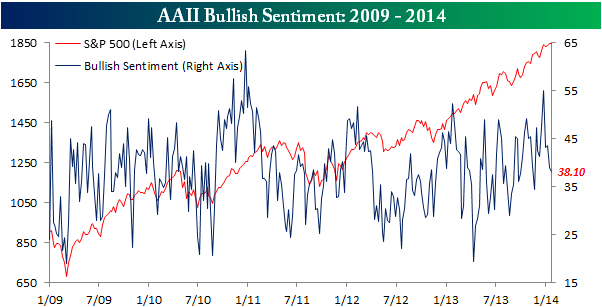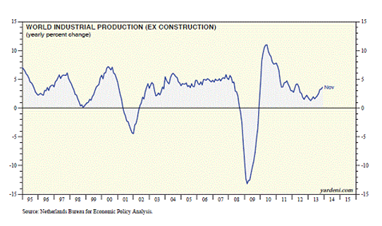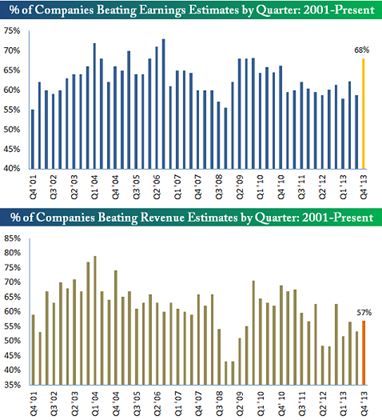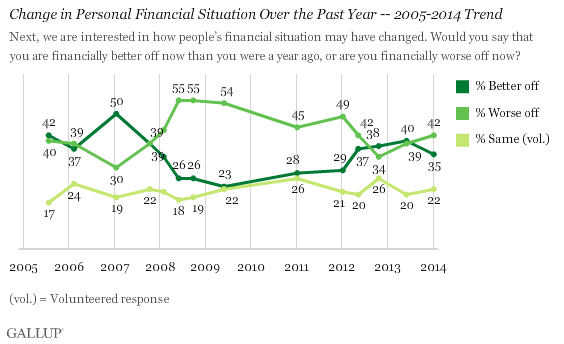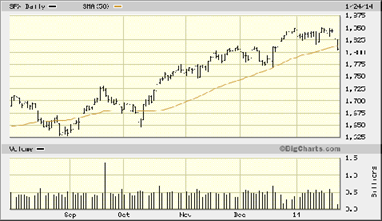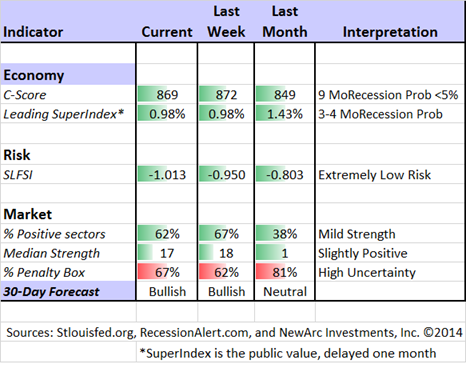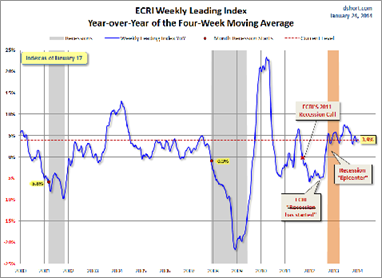After a bad week in U.S. equities and a really bad week in emerging markets, is there a relevant message? If so, does it matter for day traders, swing traders, investors, or all of the above?
The week ahead features a real free-for-all with plenty of data, Fed news, and earnings results. After weeks of a data drought, there is finally something to savor.
Last Week Recap
Last week I suggested that we would have a parade of pundits debating the idea of a market top. Earnings would take second fiddle. That was pretty accurate, especially in the Thursday and Friday selling that were described as "ugly" and "carnage" on financial TV.
This Week's Theme
The market action has taken center stage, with everyone trying to infer the message from the 2.6% decline in the S&P 500. Here are the many contenders:
- Proof that the entire 2013 rally was "built on sand" and that the Fed folly will soon be exposed. The Fed will be forced to reverse the planned tapering, which itself will be a recognition of the futility of all central bank policy.
- Proof that market valuation is in bubble territory.
- A recollection that the current issues are similar to some past crisis in Asia or Mexico or somewhere. Those past examples created a big market reaction and had memorable mnemonic names.
- Evidence that the long-expected market correction has begun.
- A "healthy" and modest correction.
- A meaningless blip, especially in the context of prior gains.
You can find backers for any and all of these horses. The biggest lesson seems to be how every pundit sweeps aside what has been happening for many months, and seizes on the "market message" from a few days as confirmation for his own preferred theory.
As always, I have some thoughts that I will share in the conclusion. First, let us do our regular update of the last week's news and data. Readers, especially those new to this series, will benefit from reading the background information.
Last Week's Data
Each week I break down events into good and bad. Often there is "ugly" and on rare occasion something really good. My working definition of "good" has two components:
- The news is market-friendly. Our personal policy preferences are not relevant for this test. And especially -- no politics.
- It is better than expectations.
The Good
Some of the recent news was good.
- Bullish sentiment declined again – a contrarian indicator. Here is the chart from Bespoke:
- The trucking index is higher – up in December after a surge in November. (See Calculated Risk).
- World industrial production is strong – a new high for the cycle. (See Ed Yardeni).
- Earnings season is going well – despite the spin and heavy emphasis on a few big names. The chart is from Bespoke. Also see Brian Gilmartin's must-read update on Q4 results and changes in forecasts.
The Bad
There was a little bad news.
- More Americans feel worse off financially than a year ago. (Via Gallup).
- Retail store closures are surging, with possible secondary effects. (Business Insider).
- China's flash PMI signals contraction. This is the HSBC/Markit version, coming out before the "official" data and with a slightly smaller completed sample. The reading was 49.6 compared to last month's 50.5. Anything below 50 signals contraction. I am scoring this as negative since Art Cashin said it accounted for 70% of Friday's market decline. Meanwhile, the level-headed John Lounsbury notes that the flash PMI has been below 50 in half of the months over the last three years. John observes that the world did not end on these occasions.
- S&P 500 challenges technical levels including breaking the 50-day moving average. Eddy Elfenbein explains:
The Ugly
Weather. Another polar vortex threatens travel, employment, retail sales, and even the Super Bowl. I am expecting 17 below tomorrow morning here in the Chicago burbs, and we're not talking wind chill!Noteworthy
Pressure from the wings --
Arizona GOP censures McCain for 'liberal' record (because the 2008 GOP Presidential nominee has supported too many liberal causes like immigration reform)
Black lawmakers to go after Obama (because of insufficient diversity in judicial appointments)
In general, investors do best when the path is open for compromise.
Quant Corner
Whether a trader or an investor, you need to understand risk. I monitor many quantitative reports and highlight the best methods in this weekly update. For more information on each source, check here.
Recent Expert Commentary on the Economy
Georg Vrba: Takes a look at potential stock returns through 2020, using the 5-year Shiller CAPE. He has also updated his market timing method, which still calls for a leveraged investment in stocks. Most recently, he examines whether there is a best time of day to trade.
RecessionAlert: Sees improvement in leading indicators for US growth, while highlighting danger areas worth monitoring. See the article for detailed charts on each indicator.
Doug Short: An update of the regular ECRI analysis with a good history and commentary – well worth reading. Here is the key chart:
See also the Cleveland version of a financial stress indicator.
The Week Ahead
This is a big week for news and data.
The "A List" includes the following:
- FOMC rate decision (W). For those who continue to believe that it is "all about the Fed" and media types needing a story, this will signal whether the pace of tapering will change.
- New home sales (M). Continuing crucial role in economic growth.
- Michigan sentiment (F). Good concurrent read on employment and spending.
- Consumer confidence (T). See Michigan above. Usually correlated with that survey, but perhaps not as good.
- Initial jobless claims (Th). Best fresh data on employment, more important than ever after last month's employment report.
- Personal income and spending (F). Key component for measuring economic improvement.
- Durable goods (T). Another of the major components of GDP.
The "B List" includes:
- Case-Shiller home prices (T). Just twenty cities and a bit lagging, but widely followed.
- GDP for Q4 (Th). The early reading will be revised twice in the near term and eventually even more. By now it is more like history, but perhaps the most important single summary measure.
- Pending home sales (Th). All housing data matters, but this less so than new construction.
- Chicago PMI (F). Prominent once again as a read on the national ISM number, coming out next week.
The State of the Union Address on Tuesday will be newsworthy, but without a clear market angle. It is still the heart of earnings season, with many important reports.
How to Use the Weekly Data Updates
In the WTWA series I try to share what I am thinking as I prepare for the coming week. I write each post as if I were speaking directly to one of my clients. Each client is different, so I have five different programs ranging from very conservative bond ladders to very aggressive trading programs. It is not a "one size fits all" approach.
To get the maximum benefit from my updates you need to have a self-assessment of your objectives. Are you most interested in preserving wealth? Or like most of us, do you still need to create wealth? How much risk is right for your temperament and circumstances?
My weekly insights often suggest a different course of action depending upon your objectives and time frames. They also accurately describe what I am doing in the programs I manage.
Insight for Traders
Felix continues to be slightly bullish. Even over the last few "neutral" weeks we have been fully invested in the top three sectors. Felix's ratings have been in a fairly narrow range for several months. These are three-week forecasts, so the jury is still out on the marginal bullish switch from last week. The ratings remain slightly positive, but many sectors are still in the penalty box.
Insight for Investors
I review the themes here each week and refresh when needed. For investors, as we would expect, the key ideas may stay on the list longer than the updates for traders. This is the "actionable investment advice" summarized here.
This is an important time for long-term investors. They all know (in theory) that market corrections of 15% or so occur regularly without any special provocation. Recent years have been the exception. Whenever there is a decline in stocks you can expect to see plenty of doomsday forecasts.
This WTWA series is designed to maintain focus on market fundamentals. The best advice comes from some favorite sources:
- Don't think you can time the market, with big "poker-style" moves of all-in or all-out. Rick Ferri draws upon one of our favorite sources to provide real data – success lower than a coin-flip. Why do you suppose that you only hear about a few big calls?
- Corporate profits should improve. Goldman Sachs economist Jan Hatzius identifies four key reasons. Hatzius is no perma-bull. He was identified by forecasting authority Nate Silver as the economist who "called" the 2008 economic decline at the right time and for the right reason. As always, it pays to follow those whose conclusions change with the evidence. And see another four reasons from Fidelity Investments' team.
- Don't cry about Argentina. Brian Gilmartin keeps it all in perspective, writing as follows:
My own opinion is that post-2008, the US Financial System and the European Developed market economies are so much stronger today, thus even if the Argentine devaluation should ripple across Latin America to Brazil, etc, the damage to the SP 500 and the US equity markets should be limited.
- There were no real surprises. Barry Ritholtz notes the discrepancy between actual data, including earnings, and the change in sentiment. As always, his entire post is well worth the read.
I am shopping for stocks. I have some cash in our long stock program, with a mission that I described in my regular annual preview interview with Seeking Alpha. The interview combines strategy, perspective, and some specific themes. As I often do, I start by emphasizing risk control. I see that as crucial in dealing with the temptations to engage in poor market timing. Several of the themes I mentioned are near the buy points.
Many investors remain cautious about stocks and want to emphasize income. At the request of several readers I wrote up an example of an actual trade, illustrating how you can improve your yield from the stodgier stocks. It does not require a rising market, and provides an extra measure of safety. You can try this at home!
While I am not trying to time a correction, I do have more than a normal cash level, raised through normal trimming. I am actively shopping in the sectors I have highlighted.
And finally, we have collected some of our recent recommendations in a new investor resource page -- a starting point for the long-term investor. (Comments and suggestions welcome. I am trying to be helpful and I love feedback).
Final Thought
I do not pretend to know what the markets will do next week. I carefully offer ideas in two time frames, described above. It would not surprise me greatly to see a short-term stock move in either direction.
There are some topics where we can have more confidence.
The Fed is not going to change policy because of Argentina or a minor decline in stocks. Neither is a sign of crisis. The Fed has a dual mandate – price stability and employment in the US. This is tough enough! The Fed will not adjust policy because some market participants have made exaggerated trades in emerging markets. Ed Yardeni has a nice summary of this issue, including this key quote:
3) Fed Chairman Ben Bernanke. In his press conference on September 18, 2013, Fed Chairman Ben Bernanke was asked for his reaction to charges coming out of emerging economies that the Fed's policies have been causing them financial distress. His initial response was that "we're watching that very carefully." Then, he went on to defend the Fed's policies as good for everyone:
The main point, I guess, I would end with, though, is that what we're trying to do with our monetary policy here is, I think, my colleagues in the emerging markets recognize, is trying to create a stronger U.S. economy. And a stronger U.S. economy is one of the most important things that could happen to help the economies of emerging markets. And, again, I think my colleagues in many of the emerging markets appreciate that--notwithstanding some of the effects that they may have felt--that efforts to strengthen the U.S. economy and other advanced economies in Europe and elsewhere ultimately redounds to the benefit of the global economy, including emerging markets as well.
The Fed will remain "data dependent" with a focus on the economy, not the stock market. I would be very surprised to see a change in the Fed "tapering" plan based upon the data we have seen. The modest changes in the strength of stimulus, something that will last for years into the future, make little real difference to the economy.
Those who wish to trade based on the Fed decision are making a guess about the perceptions of others and the short-term market impact.

